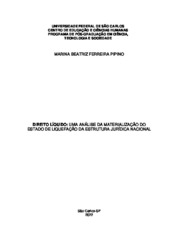| dc.contributor.author | Ferreira Pipino, Marina Beatriz | |
| dc.date.accessioned | 2022-10-20T19:13:07Z | |
| dc.date.available | 2022-10-20T19:13:07Z | |
| dc.date.issued | 2022-08-31 | |
| dc.identifier.citation | FERREIRA PIPINO, Marina Beatriz. Direito líquido: uma análise da materialização do estado de liquefação da estrutura jurídica nacional. 2022. Dissertação (Mestrado em Ciência, Tecnologia e Sociedade) – Universidade Federal de São Carlos, São Carlos, 2022. Disponível em: https://repositorio.ufscar.br/handle/ufscar/16913. | * |
| dc.identifier.uri | https://repositorio.ufscar.br/handle/ufscar/16913 | |
| dc.description.abstract | The objective of the present work is to highlight and analyze how scientific and technological development affected the national legal framework. Law is the matter chosen to establish the rules and other archetypes of social functioning. As an inherent part of society, the law reflects in its determinations the changes that society is experiencing. In the current perspective, as well as society, the law has undergone significant transformations as a result of the scientific and technological development that affected its structure, generating the following question: if the law is an inherent part of society and society has been modified by modernity, being in a state of liquefaction, then the law and its legal structure were also modified, being in the liquefaction phase. What characteristics of modernity would be present infiltrating the Brazilian legal structure? How is the national legal framework liquefying? The CTS field is an interdisciplinary area of study that brings society, science and technology together. In this way, the CTS field presented itself as the most fertile field for us to establish communication in order to analyze how scientific and technological development affected the national legal structure, answering our guiding questions. Within this field, Bauman's work “Modernidade Líquida” was the theoretical framework listed to scrutinize the inquiries, which in the end revealed the materialization of liquidity in the national legal structure. In order to reach the purpose of answering the questions and verifying at what point liquid modernity affected national law, we apply the complex methodology proposed by Morin (2004) which infers that it is not possible to think about knowledge in isolation, it is necessary to think about it in an isolated way. interdisciplinary. Together, the methodological procedures of bibliographic, historical, documentary and comparative review were also applied. | eng |
| dc.description.sponsorship | Coordenação de Aperfeiçoamento de Pessoal de Nível Superior (CAPES) | por |
| dc.language.iso | por | por |
| dc.publisher | Universidade Federal de São Carlos | por |
| dc.rights | Attribution-NonCommercial-NoDerivs 3.0 Brazil | * |
| dc.rights.uri | http://creativecommons.org/licenses/by-nc-nd/3.0/br/ | * |
| dc.subject | Desenvolvimento científico e tecnológico | por |
| dc.subject | Interfaces da modernidade | por |
| dc.subject | Interdisciplinaridade | por |
| dc.subject | Scientific and technological development | eng |
| dc.subject | Interfaces of modernity | eng |
| dc.subject | Interdisciplinarity | eng |
| dc.title | Direito líquido: uma análise da materialização do estado de liquefação da estrutura jurídica nacional | por |
| dc.title.alternative | Liquid law: an analysis of the materialization of the liquefaction state of the national legal structure | eng |
| dc.type | Dissertação | por |
| dc.contributor.advisor1 | Martinez, Vinício Carrilho | |
| dc.contributor.advisor1Lattes | http://lattes.cnpq.br/7916014556126573 | por |
| dc.description.resumo | O objetivo do presente trabalho é destacar e analisar como o desenvolvimento científico e tecnológico afetou a estrutura jurídica nacional. O direito é a matéria elegida para estabelecer as regras e outros arquétipos do funcionamento social. Por ser parte inerente da sociedade, o direito reflete, em suas determinações, as mudanças que a sociedade vive. No prisma atual, assim como a sociedade, o direito passou por significativas transformações, frutos do desenvolvimento científico e tecnológico que afetou sua estrutura, gerando-nos as seguintes indagações: se o direito é parte inerente à sociedade e a sociedade foi modificada pela modernidade – estando em um estado de liquefação –, então o direito e sua estrutura jurídica também foram modificados, igualmente estando em fase de liquefação. Quais características da modernidade estariam presentes, infiltrando-se na estrutura jurídica brasileira? Como a estrutura jurídica nacional está se liquefazendo? O campo da CTS é uma área de estudo interdisciplinar que coloca a sociedade, a ciência e a tecnologia em diálogo. Dessa forma, o campo CTS se apresentou como o campo mais fértil para estabelecermos comunicação, com o intuito de analisar como o desenvolvimento científico e tecnológico impactou a estrutura jurídica nacional, respondendo às nossas perguntas norteadoras. Dentro deste campo, a obra “Modernidade Líquida”, de Bauman, foi o marco teórico elencado para perscrutar as indagações, que ao final revelaram a materialização da liquidez na estrutura jurídica nacional. Para alcançar a finalidade de responder às indagações e verificar em que ponto a modernidade líquida afetou o direito nacional, aplicamos a metodologia complexa proposta por Morin (2004), que infere que não é possível pensar o conhecimento de modo isolado, sendo, sim, necessário pensá-lo de modo interdisciplinar. Em conjunto, também foram aplicados os procedimentos metodológicos de revisão bibliográfica, histórica, documental e comparativa | por |
| dc.publisher.initials | UFSCar | por |
| dc.publisher.program | Programa de Pós-Graduação em Ciência, Tecnologia e Sociedade - PPGCTS | por |
| dc.subject.cnpq | CIENCIAS SOCIAIS APLICADAS::DIREITO | por |
| dc.description.sponsorshipId | 88887.644999/2021-00 | por |
| dc.publisher.address | Câmpus São Carlos | por |
| dc.contributor.authorlattes | http://lattes.cnpq.br/3241016271804243 | por |


